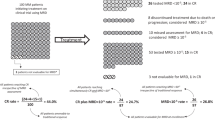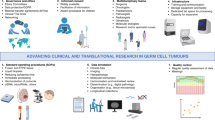Abstract
Replying to: A. H. Bretag Nature 450, 10.1038/nature06437 (2007)
Bretag1 questions our finding2 that “dogs benefited from mesoangioblast treatment”. We believe that this scepticism is not supported by careful examination of our data2.
This is a preview of subscription content, access via your institution
Access options
Subscribe to this journal
Receive 51 print issues and online access
$199.00 per year
only $3.90 per issue
Buy this article
- Purchase on Springer Link
- Instant access to full article PDF
Prices may be subject to local taxes which are calculated during checkout

Similar content being viewed by others
References
Bretag, A. H. Stem cell treatment of dystrophic dogs. Nature 450 10.1038/nature06437 (2007)
Sampaolesi, M. et al. Mesoangioblast stem cells ameliorate muscle function in dystrophic dogs. Nature 444, 574–579 (2006)
Kornegay, J. et al. The cranial sartorius muscle undergoes true hypertrophy in dogs with golden retriever muscular dystrophy. Neuromuscul. Disord. 13, 493–500 (2003)
De Luca, A. et al. A multidisciplinary evaluation of the effectiveness of cyclosporine A in dystrophic mdx mice. Am. J. Pathol. 166, 477–489 (2005)
St-Pierre, S. J. G. et al. Glucocorticoid treatment alleviates dystrophic myofiber pathology by activation of the calcineurin/NF-AT pathway. FASEB J. 18, 1937–1939 (2004)
Stupka, N. et al. The calcineurin signal transduction pathway is essential for successful muscle regeneration in mdx dystrophic mice. Acta Neuropathol. (Berl.) 107, 299–310 (2004)
Parsons, S. A. et al. Genetic disruption of calcineurin improves skeletal muscle pathology and cardiac disease in a mouse model of limb-girdle muscular dystrophy. J. Biol. Chem. 282, 10068–10078 (2007)
Dell’Agnola, C. et al. Hematopoietic stem cell transplantation does not restore dystrophin expression in Duchenne muscular dystrophy dogs. Blood 104, 4311–4318 (2004)
Schatzberg, S. J. et al. Alternative dystrophin gene transcripts in golden retriever muscular dystrophy. Muscle Nerve 21, 991–998 (1998)
Author information
Authors and Affiliations
Rights and permissions
About this article
Cite this article
Sampaolesi, M., Blot, S., Bottinelli, R. et al. Sampaolesi et al. reply. Nature 450, E23–E25 (2007). https://doi.org/10.1038/nature06438
Issue Date:
DOI: https://doi.org/10.1038/nature06438
Comments
By submitting a comment you agree to abide by our Terms and Community Guidelines. If you find something abusive or that does not comply with our terms or guidelines please flag it as inappropriate.



